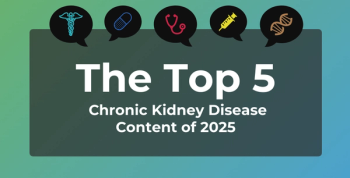
AI Can Enhance OCT Analysis for Retinal Disease Monitoring
An AI segmentation system was able to identify changes in retinal segmented features based on optical coherence tomography (OCT) images.
The baseline segmented features derived from
Diagnosing and monitoring retinal diseases is done through OCT, which is a noninvasive imaging test aimed at seeing the layers of the retinas.2 A subjective assessment of anatomical and pathological structures is used to interpret what is included in the OCT. This subjective assessment often leads to inconsistency, which makes AI an alternative to encourage a more standardized method of analysis. Being able to identify and quantify the anatomical ocular biomarkers in OCTs may help with diagnosis and treatment of eye diseases. This study applied a deep learning segmentation model to a data set of eyes treated with anti–vascular endothelial growth factor (anti-VEGF) for neovascular AMD captured by OCT imaging.
Patients eligible for this study included those who were taking anti-VEGF therapy to treat neovascular AMD from June 1, 2012, to June 30, 2017. Patients were included if they had images of both eyes at baseline and after 12 months of treatment. Follow-up visits 1, 2, 4, 6, and 12 months included imaging and clinical data collection. Baseline was the first injection and each subsequent follow-up included a subsequent injection. All patients received either aflibercept or ranibizumab.
All OCT images were entered into a 3-dimensional segmentation network. Intraretinal fluid (IRF), subretinal fluid (SRF), pigment epithelial detachment (PED), subretinal hyperreflective material (SHRM), neurosensory retina (NSR), retinal pigment epithelium (RPE), and hyperreflective foci (HRF) were all the segmented features analyzed in by the AI.
There were 2115 eyes from 1801 patients that were included in this study, of which 85.2% were receiving their first treatment. There were 1124 patients who used only aflibercept and had a mean of 7.34 injections over 12 months whereas the 376 patients who used ranibizumab only had a mean of 6.04 injections and those who switched drugs had a mean of 8.05 injections.
The mean volumes all decreased from baseline to the fourth and twelfth month in all eyes. The loading dose phase in month 2 is when the lowest IRF and SRF volumes were recorded in first-treated eyes; the second-treated eyes possessed a similar trend but the lowest IRF was in month 1. The mean IRF volumes slightly increased after 12 months when compared with month 4 but were less than the values prior to treatment; this was also found in patients with second-treated eyes. The mean SRF volumes were significantly less after 4 and 12 months when compared with baseline in second-treated eyes, but this decrease was not significant in first-treated eyes.
RPE and NSR had decreases in volume by a mean percentage of 4.81% (0.0) and 6.36% (0.0) in first-treated eyes respectively; these means were 3.63% (0.0) and 4.30% (0.0) in second-treated eyes. The mean HRF volumes decreased by 26.94% and 30.25% in first- and second-treated eyes from baseline to 4 months.
The researchers found that eyes that presented with higher SRF, IRF, and SHRM at baseline had faster reductions in RPE volume over time when compared with eyes with lower SRF, IRF, and SHRM. A significantly faster reduction in NSR volume was also found in eyes with higher IRF volume whereas higher RPE was associated with slower reduction in SRF volume.
There were some limitations to this study. The study had a retrospective design and the patients did not use the same anti-VEGF medication across the board. Location of the features within the OCT volume scan is not possible to determine using the AI system.
The researchers concluded that they “believe that AI will have great value at an individual patient level to quantify change in volumes in an automated way and personalize treatment.”1 The knowledge of how certain biomarkers in OCTs can progress with treatment could help in understanding the mechanics of the disease and how to treat the condition going forward.
References
- Moraes G, Struyven R, Wagner SK, et al. Quantifying changes on OCT in eyes receiving treatment for neovascular age-related macular degeneration. Ophthalmol Sci. 2024;4(6):100570. doi:10.1016/j.xops.2024.100570
- Turbert D. What is optical coherence tomography? American Academy of Ophthalmology. April 27, 2023. Accessed September 9, 2024. https://www.aao.org/eye-health/treatments/what-is-optical-coherence-tomography
Newsletter
Stay ahead of policy, cost, and value—subscribe to AJMC for expert insights at the intersection of clinical care and health economics.









































